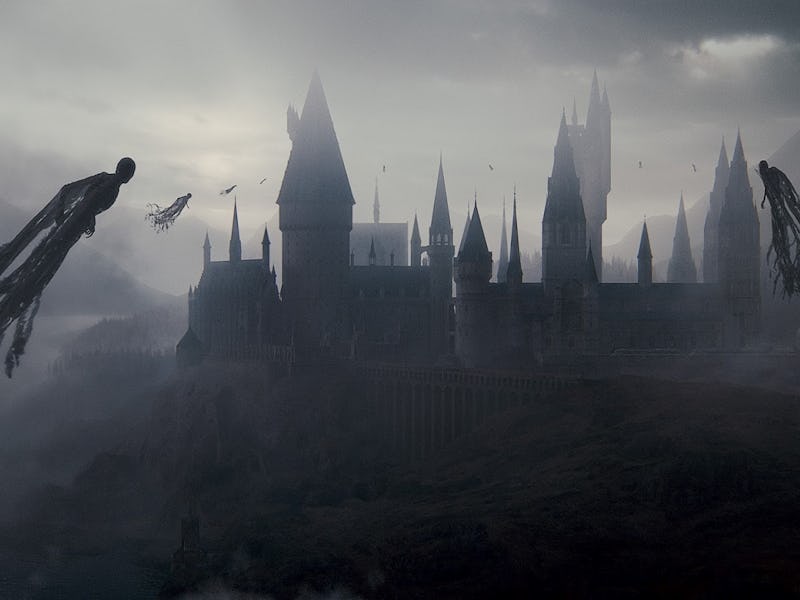Harry Potter and the VFX Revolution
From Hogwarts minis to lifelike Quidditch, here are the eight films changed the game.

Fantastic Beasts and Where to Find Them introduces a whole new world of CGI creatures, new digital environments and impressive new spells to eager Harry Potter fans. It’s the best-looking film in the franchise, which launched way back in 2001, in part because it stands on the shoulders of the giant steps made for the previous eight movies. With that in mind, here’s a look at some of the best effects shots and sequences — many of them of fantastic beasts in their own right — from those previous eight films.
Miniature Hogwarts — Harry Potter and the Sorcerer’s Stone (2001)
In nearly every one of the Harry Potter films, exterior views of the iconic Hogwarts School of Witchcraft and Wizardry were achieved via giant miniatures. Scores of effects artists from Cinesite built the miniature castle-like construction. On the first film, the school measured some 50 feet across and consisted of more than 2,500 fiber optic lights. Eventually Hogwarts would become a digital model built by studio Double Negative, so that it could be partially destroyed in Harry Potter and the Deathly Hallows — Part 2.
The gigantic Hogwarts miniature
Flying Ford Anglia — Harry Potter and the Chamber of Secrets (2002)
When Harry and Ron miss the train to Hogwarts, they ride in this flying (and sometimes invisible) car to make the journey. But it soon turns into trouble when they are nearly taken out by the train and later crash into the Whomping Willow. Although a real car was built and filmed on location and in a studio, the VFX company MPC also created a digital version that seamlessly matched the practical car for more dramatic flying — and crashing — scenes.
Buckbeak — Harry Potter and the Prisoner of Azkaban (2004)
The creation of Hagrid’s Hippogriff Buckbeak required the franchise’s VFX teams to step up to a new level. Framestore was behind this CG horse- and eagle-like creature, which was also ridden by some of the characters. To do that, a hydraulic rig filmed against green screen produced the necessary movements and then a digital model with feathers and fur was produced. Sometimes even the riders were digital, too.
Buckbeak in Draco Malfoy's grill
The Horntail Dragon Chase — Harry Potter and the Goblet of Fire (2005)
Competing in the Triwizard Tournament, Harry at one point must retrieve a golden egg guarded by an angry Horntail dragon. Industrial Light & Magic drew on its vast experience in crafting dragons to bring the creature to life. The scene was complicated by the wild broom chase above the rooftops of Hogwarts, which was rendered digitally.
The Dumbledore vs. Voldemort Battle — Harry Potter and the Order of the Phoenix (2007)
By the time the fifth movie in the franchise had come around, audiences had been hanging out for a battle between two of the most powerful wizards: Dumbledore and Voldemort. And they got it with a fire-, water- and spark-filled effects-laden duel in the Ministry of Magic. A significant portion of the VFX work here included, too, reshaping Ralph Fiennes’s nose to be more snake-like as Voldemort.
Quidditch — Harry Potter and the Half-Blood Prince (2009)
Up until this point, we’d already seen a couple of fast-paced Quidditch matches, realized with digital effects and blue screen photography with special broomstick gimbals. In Half-Blood Prince, Quidditch got a major makeover, as a combination of real photography and CG digital doubles were used by MPC to make for even more frenetic gameplay.
The VFX of Quidditch
The Death of Dobby — Harry Potter and the Deathly Hallows – Part 1 (2010)
Had audiences ever wept so much before at the death of a CG character? Have they since? The emotional death of Dobby was a marvel in giving one of the favorites of the series a tear-jerking send-off. Framestore augmented scenes of Daniel Radcliffe holding a Dobby-sized body double and dummy with a completely digital house elf. What made it extra-convincing were new ways to simulate sub-surface skin and deliver realistic cloth movement.
The Gringotts Dragon — Harry Potter and the Deathly Hallows — Part 2 (2011)
It’s too irresistible to not mention another dragon from the franchise, this time the one encountered by Ron, Harry, and Hermione underneath Gringotts Bank, which they then ride to safety. Double Negative modeled, animated, and rendered the emaciated dragon to have a particularly pale skin, although it was ferocious enough to still breathe heavy fire. The VFX studio’s model was even used by the practical effects team to laser cut a section of the dragon’s back for the actors to sit on during filming.